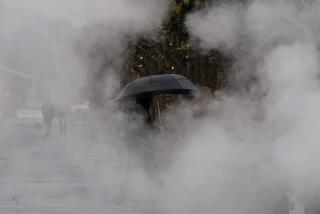Coast Guard report faults oil spill response
- Share via
SACRAMENTO — In a sobering self-assessment of the response to last year’s San Francisco Bay oil spill, a U.S. Coast Guard study released Monday conceded that the first crews on the scene dramatically underestimated the trouble and onshore commanders failed to properly alert the public and local officials.
But the 130-page report on the aftermath of the Nov. 7 spill credited oil response teams with conducting an aggressive mop-up of a fast-spreading spill that would have defied virtually any efforts at initial containment.
The report by a team of experts assembled by the Coast Guard marks the first study of the environmental tragedy that unfolded after the cargo ship Cosco Busan sideswiped the San Francisco-Oakland Bay Bridge in heavy fog, ripping a 100-foot gash in its hull and spilling more than 50,000 gallons of heavy fuel oil into the bay.
Nearly 1,700 oil-blackened seabirds died in the weeks after the spill, which eventually spread around the bay and outside the Golden Gate area -- smearing shorelines, undercutting the fishing season and outraging residents in a region known for its environmentalist ethos.
For weeks after the tragedy, state and federal lawmakers blasted the Coast Guard for its handling of the spill response, in particular for waiting until 12 hours after the accident to notify the public that initial estimates of the spill’s size were grossly underestimated.
Rear Adm. Craig Bone, the Coast Guard’s regional commander, said the report would help guide future oil-spill response by identifying areas for improvement “without placing blame or pointing fingers.”
The report concluded that the first Coast Guard crews on the scene were hampered in part by inexperience in making spill estimates and balky cooperation from the Cosco Busan crew.
After boarding the ship, Coast Guard investigators were unable to communicate with the Chinese crew and soon turned to drawing pictures and using hand signs to communicate. That led in part to the initial estimates that the ship leaked only 140 gallons.
The report said efforts need to be made to ensure that “highly trained” initial boarding teams are on hand to provide the best possible estimates of a spill’s size.
In addition, the study suggested that the Coast Guard take steps to ensure quicker and better liaison efforts with local government, the media and the public.
The agency said a final analysis found that the ship spilled 53,569 gallons of fuel oil, nearly 5,000 gallons less than estimated during the first weeks of the disaster.
But the cleanup exceeded what might have been expected compared with other spills, the report said. Over the first two weeks, 44% of the oil was mopped up.
Even so, the report took the Coast Guard and other government agencies to task for initially failing to deputize and train the hundreds of Bay Area residents who volunteered to help officials clean up the shoreline.
Such efforts could be part of future cleanup response, the report said.
The report prompted a new round of criticism from lawmakers. House Speaker Nancy Pelosi (D-San Francisco) said the report confirmed that the Coast Guard must do better. She said it was “unacceptable” that the response teams were unprepared to assess the magnitude of the disaster.
Sen. Dianne Feinstein (D-Calif.), who called the report “disappointing,” announced plans to introduce legislation in the coming days that would boost spill response preparedness and oversight while requiring that cargo ships be double-hulled if they carry more than 150,000 gallons of fuel oil.
--
More to Read
Sign up for Essential California
The most important California stories and recommendations in your inbox every morning.
You may occasionally receive promotional content from the Los Angeles Times.













